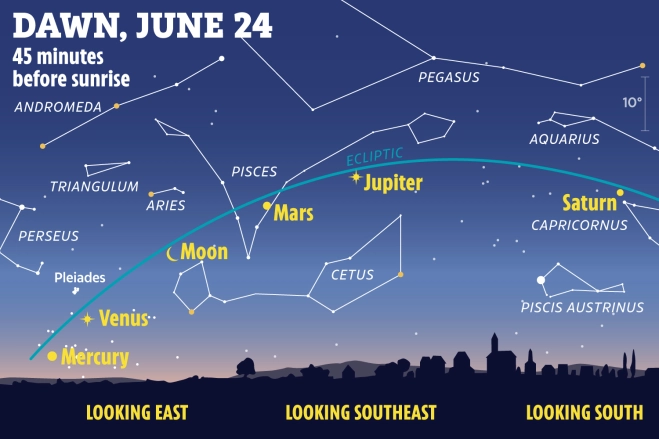STARGAZERS are in for a celestial treat tonight as SEVEN planets line up in the sky just before dawn, not one, not two, but SEVEN.
Early on Friday morning, Mercury, Venus, Mars, Jupiter, Saturn, Neptune, and Uranus will align, marking the first such alignment in 18 years.
What is the June 24 conjunction?
There will be a total of seven planets in the uncommon planet alignment.
Between June 24 and July 27, the optimum time to view is just before sunrise.
On Friday, five solar system giants will be visible to the unaided eye: Mercury, Venus, Mars, Jupiter, and Saturn.
Because of this, both novice and experienced stargazers can enjoy the event’s stellar display.
By approximately June 27, you may be able to see Uranus and Neptune using binoculars or a telescope, but they will be too dim to see without assistance.
Since December 2004, the seven planets have not been visible in a straight line over the horizon.
On June 24, at sunrise, the magnitude 5.9 Uranus will be 6 degrees to the east of the Moon in Aries.
Neptune, which is magnitude 7.8 distant and located in western Pisces, is 11.5 degrees west of Jupiter.
It will be challenging to take pictures because the line of planets will reach straight across the night sky.
If you’re prepared to get up early enough to witness it, it will provide quite the spectacle.
How to watch the conjunction
Amateur astronomer and science communicator Kevin Walsh provided directions to The Sun on how to see the unusual alignment.
On June 24, you can witness this event if you look due East around 45 minutes before sunrise, he said.
“This will happen at 3:30 a.m. for people in the North East of the UK and around 4:00 a.m. for people in the South West.
Mercury will be visible for about 30 to 40 minutes before twilight interferes, in the East North East region of the sky. Saturn will become visible in the south-eastern sky.
Walsh, one of the brains behind theeducational website theplanets.org for schoolchildren and backyard astronomers, has a wealth of expertise searching the skies.
All planet alignments (apart from Earth) are extremely uncommon, he claimed.
September 2040 is anticipated to be the date of the following alignment of the five planets visible to the naked eye.
For the greatest viewing, Walsh advised stargazers to choose a high vantage point and dress warmly.
A suitable vantage point for the majority of people, he stated, “should provide a view of the horizon in the East to observe the rise of Mercury.”
“If at all possible, try to stay away from the city centre; the high buildings and street lighting may obstruct your stargazing. Even going to a nearby park or playing field can give you a better view.”
Even if it’s summer, it can still get chilly around three in the morning, so be sure to dress appropriately.
Tom Kerss, an astronomer and the creator of Stargazing London, repeated his remarks.
Tom advised The Sun that it was worthwhile to get up early and look out of your garden or any other south or east-facing window or balcony that was available.
Even in the comparatively light summer sky, the planets are simple to identify. They don’t seem to twinkle, unlike stars, and Saturn seems faintly golden, whereas Mars is clearly orange.
Mercury and Venus, the inner planets, don’t rise very high before sunrise; Mercury in particular climbs only eight degrees before disappearing from view.
“To enjoy them, you’ll need an extremely low, ideally flat, eastern horizon that isn’t blocked by any trees or structures.
To increase your chances, it could be worthwhile to find a good viewing location beforehand.
How to watch the conjunction online
Do not worry if you live somewhere with a lot of light pollution or bad weather.
The conjunction is being streamed live by the Virtual Telescope Project from a telescope in Rome.
It implies that, if you’d prefer, you can witness the conjunction from the comfort of your own home.





















